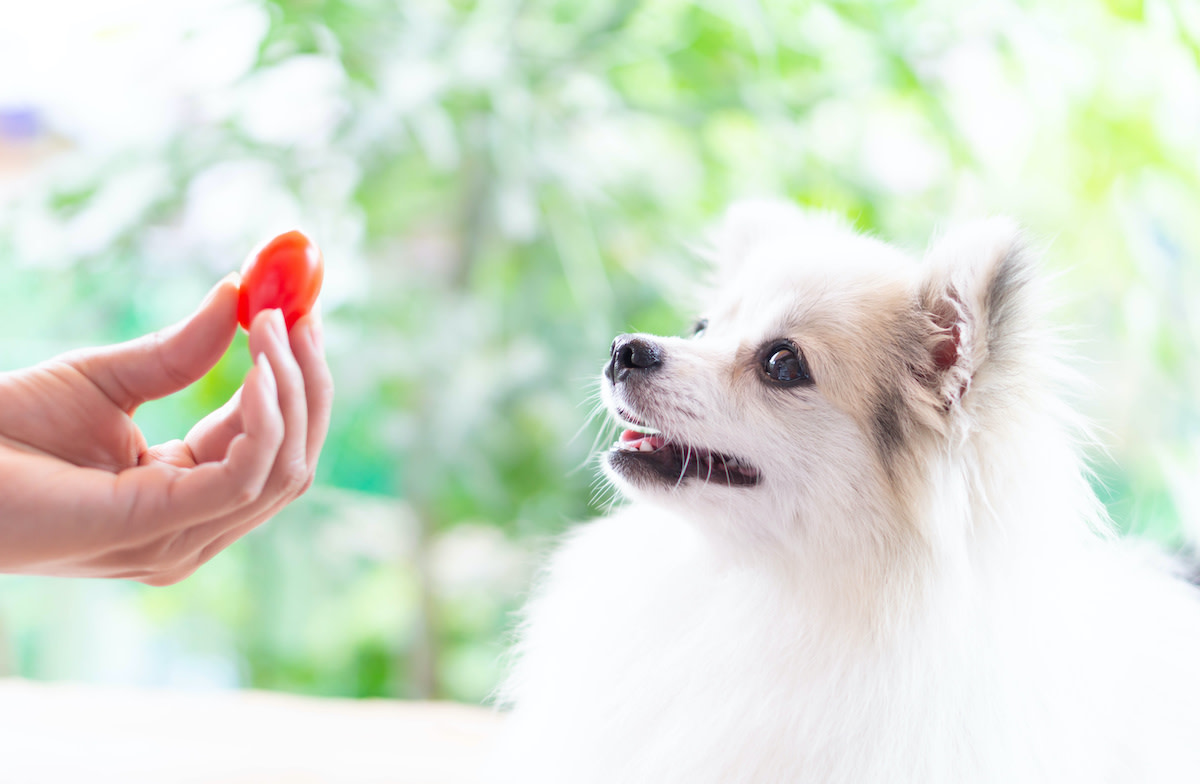Can Dogs Eat Tomatoes? Health Benefits and Considerations
Written by MasterClass
Last updated: Apr 19, 2022 • 3 min read
Dogs can eat tomatoes—which are juicy, sweet, and full of vitamins. However, there are factors to consider before offering tomatoes to your pet.
Learn From the Best
Can Dogs Eat Tomatoes?
Dogs can eat tomatoes in small quantities. Tomatoes are rich in vitamins, minerals, and antioxidants, all essential components of a dog’s diet. While the tomato fruit is safe for dogs in moderation, the tomato plant contains solanine and tomatine, toxic substances that cause health problems in dogs if eaten in large amounts. Green tomatoes have higher concentrations of solanine than red tomatoes, and ripe, red tomatoes are safer for your pet.
Can Dogs Eat Cherry Tomatoes?
Dogs can eat cherry tomatoes. The safest type of tomato to feed to your dog is a ripe tomato. Like potatoes, tomatoes are nightshades; they produce solanine, a substance toxic to dogs. Only offer your dog ripe cherry tomatoes in moderation, and remove the stem and leaves.
Can Dogs Eat Cooked Tomatoes?
Dogs can eat cooked tomatoes, but dog owners should make sure the cooked tomatoes are free of harmful preservatives or additives like garlic, onions, or salt. Check the ingredients before you offer your dog tomato sauce or canned tomatoes, as harmful additives can lead to an upset stomach. Dogs should not eat ketchup or tomato sauces with added sugar.
3 Health Benefits Tomatoes Offer Dogs
Tomatoes offer several health benefits to dogs. Tomatoes are full of:
- 1. Antioxidants: Fresh tomatoes contain many antioxidants, including lycopene and beta-carotene, which dogs convert into vitamin A.
- 2. Fiber: Tomatoes have both soluble fiber, which aids heart and digestive health, and insoluble fiber, which prevents constipation. There is more fiber in tomato pomace, the seeds, skin, and pulp left after food manufacturers process tomatoes for ketchup or soups. Tomato pomace is a common ingredient in cat and dog food since it offers dietary fiber.
- 3. Vitamins and minerals: Tomatoes are a great source of vitamins and minerals that boost your dog’s immune system. These include vitamin C, vitamin B9 (folate), potassium, and vitamin K.
Health Risks of Tomatoes for Dogs
Before feeding tomatoes to your pet, consider the following health risks:
- Illness from pesticides: Wash the fruit before giving your dog tomatoes to avoid exposing them to pesticides, which can cause gastrointestinal upset and respiratory problems.
- Tomatine poisoning: Both the tomato fruit and the green parts of the tomato plant contain tomatine, which is toxic if consumed in large quantities. Puppies, senior dogs, and small dog breeds are susceptible to tomatine poisoning after eating only small amounts of tomatoes. Symptoms of tomatine poisoning (or tomato poisoning) include: drooling, lack of coordination and muscle weakness, dilated pupils, difficulty breathing, and an erratic heart rate. Contact your doctor of veterinary medicine (DVM) if your dog displays any of these symptoms.
- Upset stomach: If consumed in excess, the high fiber content in tomatoes can cause diarrhea or other issues for your dog’s digestion.
How to Safely Portion Tomatoes for Dogs
Follow these steps to prepare tomatoes for your pet:
- 1. Wash the fruit. Always rinse tomatoes to remove any dirt or pesticides.
- 2. Remove the green parts. Tomatine, a toxic substance for dogs, is present in the plant's stem and leaves. Trim away these parts before serving tomatoes to your pooch.
- 3. Start small. When you introduce a new food, start with small portions. See how your dog reacts to tomatoes before giving them more.
- 4. Feed as a treat. Use tomatoes as a snack or reward rather than a substitute for a balanced diet. Limit treats to ten percent of your dog’s daily caloric intake; one or two pieces of tomato per day is sufficient.
Before Sharing With Your Pooch
Certain human foods can cause adverse reactions in canines, so always consult your veterinarian to determine whether it is safe to add these foods to your pet’s diet. This article is for educational and informational purposes and is not a substitute for medical or dietary advice.
Want to Learn More About Training the Goodest Boy or Girl?
Your dream of having a dog who understands words like “sit,” “stay,” “down,” and—crucially— “no” is just a MasterClass Annual Membership away. The only things you’ll need to train up a well-behaved pup are your laptop, a big bag of treats, and our exclusive instructional videos from superstar animal trainer Brandon McMillan.
